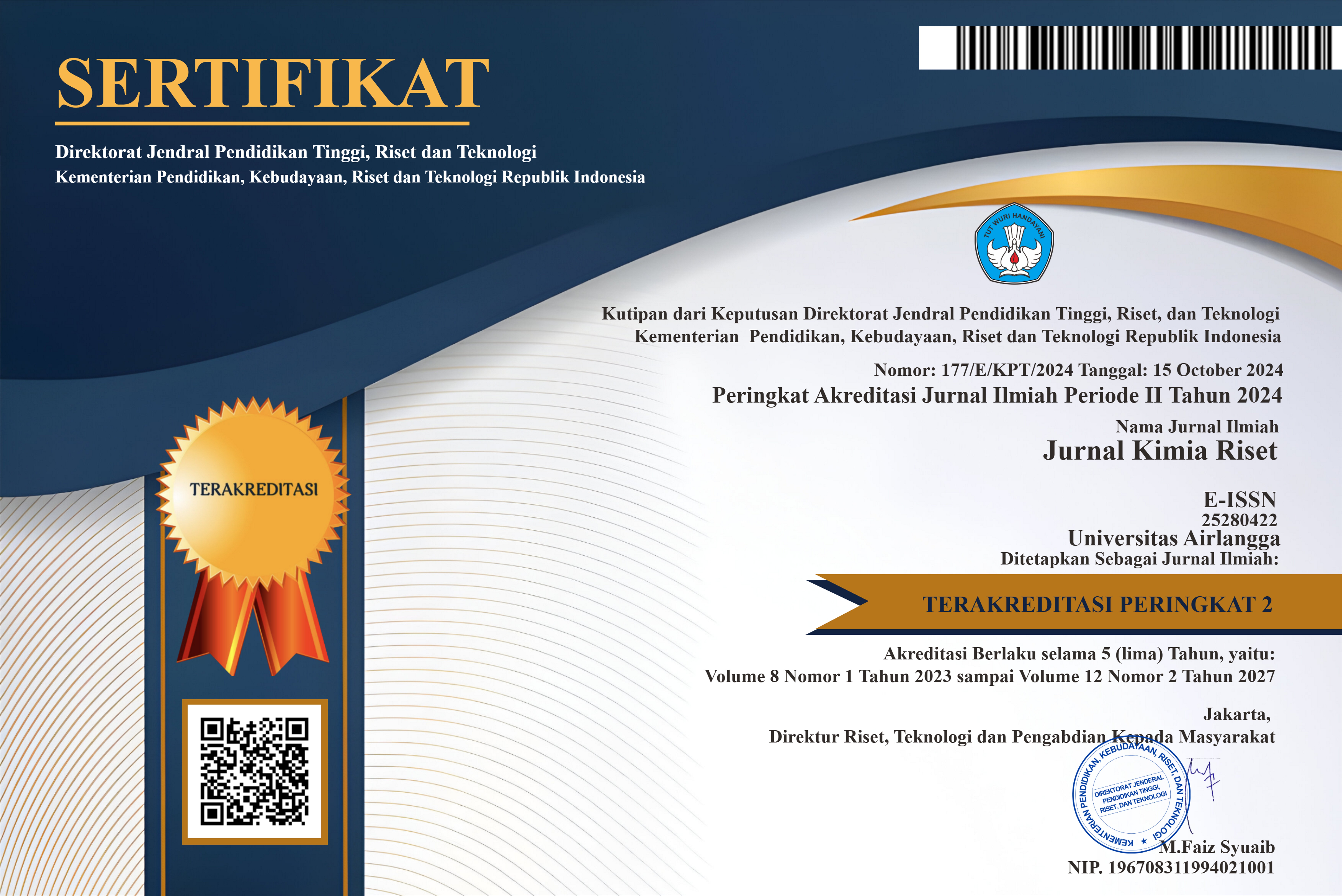EFFECT OF CATALYST PROPERTIES ON THE DEOXYGENATION REACTION OF VEGETABLE OIL AND MODEL COMPOUND TO PRODUCE DIESEL RANGE HYDROCARBON FUELS: A REVIEW
Downloads
The concern associated with the depletion of fossil fuel energy has opened up windows of opportunity for researchers to develop potential energy from renewable resources. The renewable green diesel with diesel range hydrocarbon structure has gained increasing popularity by removing oxygen molecule via direct or hydrodeoxygenation (HDO) and indirect or deoxygenation (DO) reaction. The catalyst design is an important key to achieve the high quality of diesel range hydrocarbon fuels. The different catalyst properties effect to the distribution of deoxygenated liquid product, the catalytic activity and coke formation during the reaction process. The interaction between metal and support catalyst causes electron transfer to give the synestistic effect. The acidity and basicity play important role in C-C and C-O breaking bond in triglyceride and prevent the coke formation. The pore structure and pore size catalyst provide the accessibility of active sites alleviates the diffusion limitation of reactants/ products.
Alsultan, G.A., Asikin-Mijan, N., Lee, H. V., Albazzaz, A.S. and Taufiq-Yap, Y.H., 2017. Deoxygenation of waste cooking to renewable diesel over walnut shell-derived nanorode activated carbon supported CaO-La2O3 catalyst. Energy Conversion and Management, 151, 311–323.
Asikin-Mijan, N, Lee, H. V, Juan, J.C., Noorsaadah, A.R. and Taufiq-Yap, Y.H., 2017. Catalytic deoxygenation of triglycerides to green diesel over modi fi ed CaO-based catalysts. RSC Advances, 46445–46460.
Asikin-Mijan, N., Lee, H. V., Juan, J.C., Noorsaadah, A.R., Ong, H.C., Razali, S.M. and Taufiq-Yap, Y.H., 2018. Promoting deoxygenation of triglycerides via Co-Ca loaded SiO2-Al2O3 catalyst. Applied Catalysis A: General, 552, pp.38–48.
Asikin-mijan, N., Lee, H. V, Marliza, T.S. and Tau, Y.H., 2018. Pyrolytic deoxygenation of triglycerides model compound and non-edible oil to hydrocarbons over SiO2 -Al2O3 supported NiO-CaO catalysts. Journal of Analytical and Applied Pyrolysis, 129, 221–230.
Baharudin, K.B., Taufiq-Yap, Y.H., Hunns, J., Isaacs, M., Wilson, K. and Derawi, D., 2019. Mesoporous NiO/Al-SBA-15 catalysts for solvent-free deoxygenation of palm fatty acid distillate. Microporous and Mesoporous Materials, 276, 13–22.
Baharudin, K.B., Arumugam, M., Hunns, J., Lee, A.F., Mayes, E., Taufiq-Yap, Y.H., Wilson, K. and Derawi, D., 2019. Octanoic acid hydrodeoxygenation over bifunctional Ni/Al-SBA-15 catalysts. Catalysis Science and Technology, 9(23), 6673–6680.
Choo, M., Oi, L.E., Ling, T.C., Ng, E., Lin, Y., Centi, G. and Juan, J.C., 2020. Deoxygenation of Triolein to Green Diesel in the H2-free condition: Effect of Transition Metal Oxide Supported on Zeolite Y. Journal of Analytical and Applied Pyrolysis, `47, 104797.
Gómez, J.M., Díez, E., Rodríguez, A. and Calvo, M., 2018. Synthesis of mesoporous X zeolite using an anionic surfactant as templating agent for thermo-catalytic deoxygenation. Microporous and Mesoporous Materials, 270, 220–226.
Gosselink, R.W., Hollak, S.A.W., Chang, S.W., Van Haveren, J., De Jong, K.P., Bitter, J.H. and Van Es, D.S., 2013. Reaction pathways for the deoxygenation of vegetable oils and related model compounds. ChemSusChem, 6(9), 1576–1594.
Hengsawad, T., Jindarat, T., Resasco, D.E. and Jongpatiwut, S., 2018. Synergistic effect of oxygen vacancies and highly dispersed Pd nanoparticles over Pd-loaded TiO2 prepared by a single-step sol–gel process for deoxygenation of triglycerides. Applied Catalysis A: General, 566, 74–86.
Hermida, L., Zuhairi, A. and Rahman, A., 2015. Deoxygenation of fatty acid to produce diesel-like hydrocarbons : A review of process conditions , reaction kinetics and mechanism. Renewable and Sustainable Energy Reviews, 42, 1223–1233.
Hu, C., Du, X., Li, D., Xin, H., Zhou, W., Yang, R. and Zhou, K., 2019. The Conversion of Jatropha Oil into Jet Fuel on NiMo/Al-MCM-41 Catalyst: Intrinsic Synergic Effects between Ni and Mo. Energy Technology, 7(5), 1–14.
Kamaruzaman, M.F., Taufiq-Yap, Y.H. and Derawi, D., 2020. Green diesel production from palm fatty acid distillate over SBA-15-supported nickel, cobalt, and nickel/cobalt catalysts. Biomass and Bioenergy, 134(October 2019), 105476.
Kubicˇka, D. and Kubicˇkova´, I., 2010. Utilization of Triglycerides and Related Feedstocks for Production of Clean Hydrocarbon Fuels and Petrochemicals : A Review. Waste and Biomass Valorization, 1, 293–308.
KubiÄka, D., HoráÄek, J., SetniÄka, M., Bulánek, R., Zukal, A. and KubiÄková, I., 2014. Effect of support-active phase interactions on the catalyst activity and selectivity in deoxygenation of triglycerides. Applied Catalysis B: Environmental, 145, 101–107.
Lee, S.U., Kim, E.S., Kim, T.W., Kim, J.R., Jeong, K.E., Lee, S. and Kim, C.U., 2020. Effect of silica supports on deoxygenation of methyl palmitate over mesoporous silica-supported Ni/Al catalysts. Journal of Industrial and Engineering Chemistry, 83, 366–374.
Loe, R., Santillan-Jimenez, E., Morgan, T., Sewell, L., Ji, Y., Jones, S., Isaacs, M.A., Lee, A.F. and Crocker, M., 2016. Effect of Cu and Sn promotion on the catalytic deoxygenation of model and algal lipids to fuel-like hydrocarbons over supported Ni catalysts. Applied Catalysis B: Environmental, 191, 147–156.
Lup, A.N.K., Abnisa, F., Mohd, W. and Wan, A., 2017. A review on reactivity and stability of heterogeneous metal catalysts for deoxygenation of bio-oil model compounds. Journal of Industrial and Engineering Chemistry, 56, 1–34.
Miao, C., Marin-Flores, O., Davidson, S.D., Li, T., Dong, T., Gao, D., Wang, Y., Garcia-Pérez, M. and Chen, S., 2016. Hydrothermal catalytic deoxygenation of palmitic acid over nickel catalyst. Fuel, 166, 302–308.
Nugraha, R.E., Prasetyoko, D., Bahruji, H., Suprapto, S., Asikin-Mijan, N., Oetami, T.P., Jalil, A.A., Vo, D.-V.N. and Yun Hin, T.-Y., 2021. Lewis acid Ni/Al-MCM-41 catalysts for H2-free deoxygenation of Reutealis trisperma oil to biofuels. RSC Advances, 11, 21885–21896.
Nugraha, R.E., Prasetyoko, D., Asikin-Mijan, N., Bahruji, H., Suprapto, S., Taufiq-Yap, Y.H. and Jalil, A.A., 2021. The effect of structure directing agents on micro/mesopore structures of aluminosilicates from Indonesian kaolin as deoxygenation catalysts. Microporous and Mesoporous Materials, 315, 110917.
Oh, M., Jin, M., Lee, K., Kim, J.C., Ryoo, R. and Choi, M., 2022. Importance of pore size and Lewis acidity of Pt/Al2O3 for mitigating mass transfer limitation and catalyst fouling in triglyceride deoxygenation. Chemical Engineering Journal, 439, 135530.
Oi, L.E., Choo, M.Y., Lee, H.V., Taufiq-Yap, Y.H., Cheng, C.K. and Juan, J.C., 2020. Catalytic deoxygenation of triolein to green fuel over mesoporous TiO2 aided by in situ hydrogen production. International Journal of Hydrogen Energy, 45, 11605–11614.
Ooi, X.Y., Gao, W., Chyuan, H., Voon, H., Ching, J., Hsin, W. and Teong, K., 2019. Overview on catalytic deoxygenation for biofuel synthesis using metal oxide supported catalysts. Renewable and Sustainable Energy Reviews, 112, 834–852.
Pattanaik, B.P. and Misra, R.D., 2017. Effect of reaction pathway and operating parameters on the deoxygenation of vegetable oils to produce diesel range hydrocarbon fuels: A review. Renewable and Sustainable Energy Reviews, 73, 545–557.
Popov, S. and Kumar, S., 2015. Rapid hydrothermal deoxygenation of oleic acid over activated carbon in a continuous flow process. Energy and Fuels, 29(5), 3377–3384.
Puértolas, B., Keller, T.C., Mitchell, S. and Pérez-ramírez, J., 2016. Deoxygenation of bio-oil over solid base catalysts : From model to realistic feeds. Applied Catalysis B: Environmental, 184, 77–86.
Qian, E.W., Chen, N. and Gong, S., 2014. Role of support in deoxygenation and isomerization of methyl stearate over nickel – molybdenum catalysts. "Journal of Molecular Catalysis. A, Chemical”, 387, 76–85.
Reangchim, P., Saelee, T., Itthibenchapong, V., Junkaew, A., Chanlek, N., Eiad-Ua, A., Kungwan, N. and Faungnawakij, K., 2019. Role of Sn promoter in Ni/Al2O3 catalyst for the deoxygenation of stearic acid and coke formation: Experimental and theoretical studies. Catalysis Science and Technology, 9(13), 3361–3372.
Rogers, K.A. and Zheng, Y., 2016. Selective Deoxygenation of Biomass-Derived Bio-oils within Hydrogen-Modest Environments : A Review and New Insights, 1750–1772.
Safa Gamal, M., Asikin-Mijan, N., Arumugam, M., Rashid, U. and Taufiq-Yap, Y.H., 2019. Solvent-free catalytic deoxygenation of palm fatty acid distillate over cobalt and manganese supported on activated carbon originating from waste coconut shell. Journal of Analytical and Applied Pyrolysis, 144
Santillan-jimenez, E., Morgan, T., Lacny, J., Mohapatra, S. and Crocker, M., 2013. Catalytic deoxygenation of triglycerides and fatty acids to hydrocarbons over carbon-supported nickel. Fuel, 103, 1010–1017.
Shi, Y., Xing, E., Cao, Y., Liu, M., Wu, K., Yang, M. and Wu, Y., 2017. Tailoring product distribution during upgrading of palmitic acid over bi-functional metal/zeolite catalysts. Chemical Engineering Science, 166(x), 262–273.
Silva, F.C.M., Lima, M.S., Neto, C.O.C., Sá, J.L.S. and Souza, L.D., 2018. Catalytic deoxygenation of C18 fatty acids over HAlMCM-41 molecular sieve. Biomass Conversion and Biorefinery, 8, 159–167.
Sousa, F.P., Silva, L.N., de Rezende, D.B., de Oliveira, L.C.A. and Pasa, V.M.D., 2018. Simultaneous deoxygenation, cracking and isomerization of palm kernel oil and palm olein over beta zeolite to produce biogasoline, green diesel and biojet-fuel. Fuel, 223, 149–156.
Veses, A., PueÌrtolas, B., LoÌpez, J.M., CalleÌn, M.S., Solsona, B. and García, T., 2016. Promoting Deoxygenation of Bio-Oil by Metal-Loaded Hierarchical ZSM "‘ 5 Zeolites. ACS Sustainable Chemistry and Engineering, 4(5), 1653–1660.
Wang, H., Lin, H., Zheng, Y., Ng, S., Brown, H. and Xia, Y., 2019a. Kaolin-based catalyst as a triglyceride FCC upgrading catalyst with high deoxygenation, mild cracking, and low dehydrogenation performances. Catalysis Today, 319, 164–171.
Xing, S., Lv, P., Zhao, C., Li, M., Yang, L., Wang, Z., Chen, Y. and Liu, S., 2018a. Solvent-free catalytic deoxygenation of oleic acid via nano-Ni/HZSM-5: Effect of reaction medium and coke characterization. Fuel Processing Technology, 179, 324–333.
Yang, L. and Carreon, M.A., 2017. Deoxygenation of Palmitic and Lauric Acids over Pt/ZIF-67 Membrane/Zeolite 5A Bead Catalysts. ACS Applied Materials and Interfaces, 9(37), 31993–32000.
Zhao, S., Zhang, Z., Zhu, K. and Chen, J., 2017. Hydroconversion of methyl laurate on bifunctional Ni 2 P/AlMCM-41 catalyst prepared via in situ phosphorization using triphenylphosphine. Applied Surface Science, 404, 388–397.
Zheng, Y., Zhao, N. and Chen, J., 2019. Enhanced direct deoxygenation of anisole to benzene on SiO2-supported Ni-Ga alloy and intermetallic compound. Applied Catalysis B: Environmental, 250(March), 280–291.
Zulkepli, S., Juan, J.C., Lee, H.V., Rahman, N.S.A., Show, P.L. and Ng, E.P., 2018. Modified mesoporous HMS supported Ni for deoxygenation of triolein into hydrocarbon-biofuel production. Energy Conversion and Management, 165(March), 495–508.
Copyright (c) 2022 Jurnal Kimia Riset

This work is licensed under a Creative Commons Attribution-NonCommercial-ShareAlike 4.0 International License.
COPYRIGHT NOTICE
1. By submitting the article to Jurnal Kimia Riset (JKR), the author has agreed to transfer some of the copyrights to the publisher of the research chemistry journal, Universitas Airlangga, indicated in the Copyright Transfer Agreement.
2. Authors still retain significant rights to use and share their own published articles for non-commercial purposes subject to Creative Commons Attribution-NonComercial 4.0 International License
3. All publications (printed/electronic) are open access for educational purposes, research, library, and other non-commercial purposes. Besides the purposes mentioned above, the editorial board is not responsible for copyright violations.















